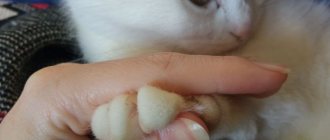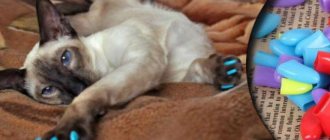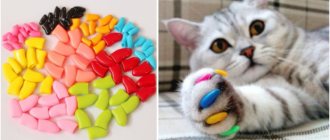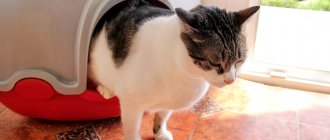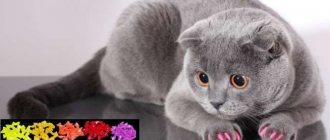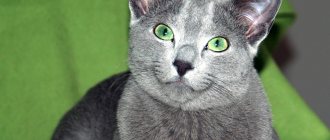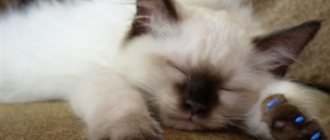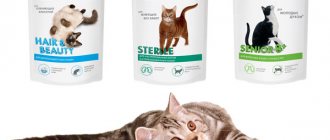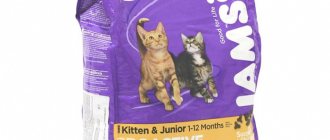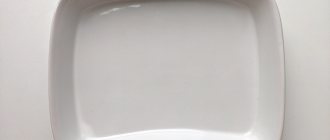Every cat lover knows firsthand what ties on furniture are. Cats love to sharpen their claws on everything they like: furniture, clothes, curtains, carpets, etc. They do this not “out of harm.” Sharpening claws is a natural need of an animal. Of course, you can simply trim your pet’s nails, but animals are not happy with this procedure. And the owners themselves do not always like this painstaking and dangerous task.
- 2 Benefits and harms of anti-scratch products for cats
- 3 How to choose anti-scratch products for cats of different ages
- 4 Rules for using anti-scratch pads
4.1 When not to cap cats’ claws
- 4.2 How to glue cat claw caps
- 6.1 Video: anti-scratch in action
What kind of device are anti-scratchers for cats?
Owners owe the appearance of silicone caps on the pet supply market to the American veterinarian Toby Wexler. He was against the inhumane method of declawing and figured out how to avoid it. This happened in 2003.
Appearance
The tips are made of silicone, which does not contain toxic elements. They are created in such a way that they fully correspond to the anatomical shape, repeating all the curves. The tips themselves do not injure the paw and do not even prevent the retraction of the claw. Now there is a wide range on sale:
- different colors (red, green, yellow, purple, black);
- transparent;
- fluorescent (glow in the dark);
- with sparkles.
The caps are attached with medical glue, which is absolutely safe for any living beings. If your pet chews and tries to swallow its accessory, then no harm will come from it. Anti-scratch pads can be used not only for cats, but also for small breed dogs.
Purpose
Silicone accessories, which were invented in the USA, are widely distributed throughout the world. For now, this is the only humane way to save furry owners from troubles with damaged wallpaper, furniture and curtains. But combating damage to things is not the only purpose of anti-scratch products for cats. They are successfully used in the following situations:
- Health problems for the owner or his family members. Diseases include problems with blood clotting or allergies of various types.
- Presence of small children in the apartment. Kids can provoke even the most phlegmatic fluffy into aggression. Silicone kits will help protect your child from injury.
- Aggressive cats. Some animals, due to their breed or character traits, can rush at people at the slightest irritation. Also, pets with illnesses may demonstrate hostility towards humans before recovery.
You should not purchase tips just for their attractive appearance. If the pet is not mischievous or does not demonstrate inappropriate behavior, then the use of such devices is not relevant.
average price
Cat claw caps are sold in sets of 20 or 40 pieces. The kit comes with instructions and medical glue. The average cost of a set is 250-350 rubles. (for 20 pieces).
If the price is an order of magnitude lower, then this is a reason to doubt the quality of the devices. Usually, kits with low-quality glue are cheaper, which can become unsafe, causing allergies or poisoning.
Types of nail tips
Nail tips come in different types: silicone, rubber and plastic. A variety of colors has a practical meaning - the owner can see if the cover is lost, and it is convenient to find it in the room.
Advantages of using silicone pads
Silicone pads are the most popular among owners, since the material rarely causes allergies, adheres well and does not hinder the natural movements of the animal.
How to make anti-scratch for a cat with your own hands
If desired, the owner can make anti-scratch bars for a cat on his own, using silicone and polypropylene.
The benefits and harms of caps
Any pet product has both positive and negative characteristics. This is explained by the peculiarity of mustaches, their individual needs and character, as well as the preferences of the owner.
Undeniable advantages
The positive aspects of wearing silicone pads are obvious, and there are quite a lot of them. The main thing is that the mustache normally perceives their presence on its paws and does not try to chew them off. Advantages of devices:
- keeping furniture, walls and curtains in good condition;
- lack of possibility of causing injury to a person;
- Can be used at any age.
When worn correctly, these cute little silicone things won't cause any discomfort to your furry friend. Over time, he will stop paying attention to them, and then the owner will be completely calm about the safety of his home.
Possible disadvantages
Of course, there are also negative sides to using tips. However, they can be avoided with the correct selection of accessories. It is important to consider not only the attractive appearance of the product, but also how comfortable the mustache is.
The disadvantages that may arise include:
- fragility (maximum month, and average service life - 2 weeks);
- different period of adaptation - the cat may never get used to the innovation;
- they squeak unpleasantly or knock on the floor when walking or burying the tray;
- possible deformation of the nail plates, their separation.
Fluffy purrs, like people, have different mentalities. Therefore, the period of adaptation for some pets may take a couple of weeks, while others will forget about the caps in just a couple of hours.
Age restrictions
Manufacturers of products for mustachioed consumers claim that there are no restrictions on the use of stickers. However, veterinarians do not agree with this. In their opinion, it is not advisable to use kits for kittens up to six months of age. Their nail plates themselves are very soft and easily wear off when walking or playing.
Nail caps are not useful for older cats. Old people usually lose interest in curtains and pieces of furniture, so there is no point in protecting them.
The same can be said about free-ranging animals. An individual who spends a lot of time outdoors will not be able to climb a tree or protect itself from enemies if cute accessories are put on it.
Effect on claw growth
Before subjecting their pet to the anti-scratch sticker procedure, breeders are interested in how silicone pads affect the development of claws. Experts agree that properly secured protection does not affect the natural growth of the horny processes. However, an overlay that is too long and not chosen to fit can grow into the pad, causing tissue inflammation. To avoid negative consequences, you need to choose protection from a smaller range, and also periodically inspect the paws.
Choice among variety
The right product successfully replaces the removal or trimming of the nail plate. The main thing is to guess the size and buy harmless glue.
Size is the most important thing
When purchasing, you need to take into account the weight and thickness of the nail plate of the homemade mustache. A sizing guide can be found on any package with caps. Conventionally, there are 4 types:
- For small animals and kittens (up to 1.5 kg) – the smallest size is XS.
- For fluffies weighing from 1.5 to 4 kg, S is suitable.
- For individuals with a body weight of 4-6 kg, size M is intended.
- For large breeds or dogs weighing more than 6 kg, use size L.
High-quality products are made from thin and pliable silicone, which does not wear out for a long time and does not cause discomfort to the cat. Cheap analogues quickly crack, fly off and cause a lot of inconvenience. Therefore, quality and size are the determining factors when purchasing protective devices.
What about glue?
Not only the material from which the pet product is made is important, but also the glue included in the set. This substance should do more than just keep the cap on the animal's paw. The comfort of wearing devices depends on the quality of the glue. If it contains harmful components or is expired, then irritation and inflammation may occur from its use.
When purchasing a kit, you need to make sure that the glue included in the kit has a medical purpose and a good shelf life. If the product was purchased a long time ago, then the spoiled composition can be replaced with the appropriate one from the pharmacy.
How to use
The first attempt to use overlays is not always successful. But this does not mean that you should give up silicone caps - you should be persistent and not give up.
Preparing animal claws
To carry out the first stickers, it is important to enlist the support of one of the family members. This will make the first attempt more successful and less traumatic.
First, you need to carefully examine the claws of your furry friend. They often differ in length, so the tip is tried on each finger separately.
A little pressure is applied to the paw pad so that the cat opens it, after which 2-3 mm of the claw is cut off with special nippers. The cut can be sharpened with a soft file, then there will be no sharp edges left.
Next, try on the overlay. It is important to make sure that it is pressed tightly and that there is 2 mm left to the base of the claw. Tips that are too long can be shortened slightly to make them easier to wear. To do this, the edges are trimmed with nail scissors.
In long-haired cats, long fur between the toes often gets in the way. In order not to stain it with glue, it is recommended to cut off any protruding hairs immediately before the procedure.
Algorithm for gluing procedure
Detailed instructions on how to glue anti-scratch pads to cats' claws are included with each kit. It is the same for protective sets of any size and color. The gluing algorithm looks like this:
- Glue is poured inside the lining, which should fill no more than half of it.
- By pressing on the pad with your fingers, you need to release the claw so that it appears at its full length.
- Step back 2 mm from the base and put on the tip, avoiding any glue getting on the fur.
- Hold for up to 10 seconds for better adhesion.
- Do not let go of your pet for 5-7 minutes so that the glue dries completely and sets.
During the procedure, the cat should experience a minimum of discomfort. Otherwise, re-sticking will not arouse positive expectations in him, and then it will be difficult to force him to this procedure.
Precautionary measures
It is more convenient and safer for the owner to use protective nails only on the front paws of the pet. This is also rational - it is with them that fluffies cause harm to surrounding objects.
The hind legs can be left alone. As a last resort, they can be filed or lightly trimmed.
During the procedure, the mustachioed friend must be securely fixed so that he cannot harm the person, run away during the procedure, or get dirty in the glue. It is better to stick the caps together: one holds, the other performs manipulations. You can’t put too much pressure on your pet, much less cause him pain.
After complete drying, watch your pet so that he does not actively chew the silicone. Distract your furry one with a treat or game.
Do not let the glue come into contact with your own hands or the cat's fur. The glue will be difficult to wash off, so it is better to use gloves or an old blanket in which you can wrap a restless animal.
How often do you need to change the pads?
You should not remove the caps yourself, especially if this is not associated with a threat to health and life. The additional manipulation of removing the tips will cause further stress for the cat. Objective factors that require ridding the animal of protective kits are:
- allergic reaction;
- improper gluing;
- prolonged nervousness.
It is important to understand that this is not only decoration. They cannot be changed when the owner is tired of the appearance. A person’s whim is not a reason to subject an animal to an unnecessary procedure.
Contraindications, possible complications
If the cat is accustomed to a scratching post, does not show aggression and does not damage furniture, it may not need anti-scratch claws.
There are a number of restrictions that make it better to avoid sticking protective caps. Veterinarians indicate the main ones:
- The animal is walking on the street. In case of danger, the cat will not be able to defend itself or climb a tree.
- Allergic reaction to glue. Symptoms of intolerance may occur immediately or after a few days. To help in a timely manner, it is necessary to periodically examine the cat for the appearance of redness or irritation.
- The presence of dermatitis or fungal diseases. Anti-scratch pads can only be applied to the claws of a healthy cat.
- Age of the kitten. If there is a need to use caps for an animal that is less than six months old, it is better to consult a veterinarian.
- Prolonged stress. When a cat has lost interest in food and games, it is better not to aggravate the situation.
Duration of use
Protective accessories fall off the paws on their own as the nail plate grows. Therefore, their service life is related to the health, lifestyle and behavior of the cat. On average, the period of wearing the kit lasts from 2 to 4 weeks, and sometimes reaches 2 months.
In some cases they may be lost. The eared friend leaves them in the long pile of the carpet or chews them off.
Anti-scratch vs surgery, scratching post and trimming
In addition to protective kits, the pet store also offers other means designed to save your home from destruction: sprays, special pheromones, which, alas, do not always work.
Another effective, but completely unacceptable for any pet, method is onychectomy - surgical removal of the claw and part of the finger. This is a very dangerous procedure that leads to dire consequences. The cat becomes disabled and cannot lead a full life and take care of itself. Many animals lose their mental health after onychectomy, which is why the operation is prohibited by law in some countries.
A scratching post becomes a solution if the cat has been trained to use it. In other cases, it simply does not work - or the pet uses both the scratching post and the owner’s favorite chair.
Trimming nails is only partially effective. Claws grow quickly, and they sharpen even faster. They have to be trimmed with a nail file all the time, and this takes a long time. Not every cat will sit for 10 minutes and endure the unpleasant procedure.
Therefore, protective kits become the best alternative. They can be used regularly, or for a short period of time - for example, during a trip, a long stay with relatives with small children, or a visit to the veterinarian.
Replacement frequency
Cats' claws grow constantly, which necessitates periodic replacement of protective caps. The maximum period for using one set is 45-60 days. During this time, a healthy pet replaces old claws with new ones. The attachment will last its stated lifespan for a lazy, sedentary cat, for whom the anti-scratch pads will not cause discomfort.
Usually, animals don’t wear the first set for long. For several days after gluing, the cat will get used to new sensations and foreign objects clinging to its claws. After developing the habit, an active and playful furry will be able to wear the caps for about two weeks. If the cat is nervous and does not tolerate encroachments on his personal space, he will be able to rip off the protection faster. In this case, the pet often swallows the pads, but they do not cause harm and pass freely through the gastrointestinal tract.
What do veterinarians say?
There are no clear reviews among veterinarians about anti-scratch products for cats. But most doctors tend to recommend them for their mustachioed patients.
Common Myths
Despite the fact that manufacturers insist that silicone claws are completely safe for the health of your mustachioed friend, there are quite a lot of myths about their use. Here are the most common reasons why owners do not want to purchase the “soft paws” accessory:
- The claws itch underneath. This is incorrect because there are no nerve endings on the nail plate.
- They interfere with retracting the claws. In fact, everything is attached to the tip, which sticks out of the pad.
- The animal's gait changes greatly. This is true, but not for all cats and for a very short period of time.
- The material and glue are toxic. Manufacturers and veterinarians say this is not true. Even ingestion cannot harm your pet.
To make use as comfortable as possible, it is necessary to follow the order of gluing them. In addition, when choosing silicone kits at a pet store, it is important to carefully read their composition and instructions.
At what age can you wear it?
It is not advisable to attach such pads to a very small animal.
There is no exact indication when it is better to start gluing pads, but it is recommended not to start using anti-scratch products for cats before the 6th month of a kitten’s life. Before this, the animal’s claws are very soft and wear down on their own during play. And if you put on false accessories at 2 months, you can only damage the pet’s claws, since they are not yet formed.
